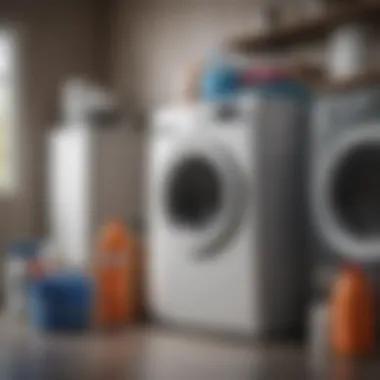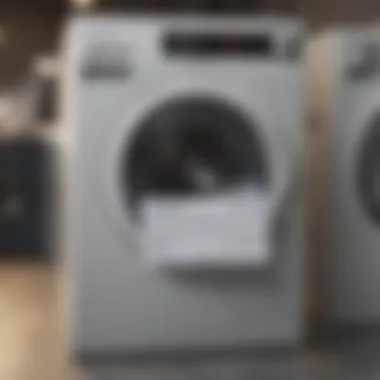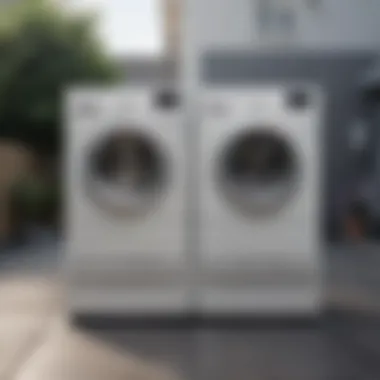Deep Cleaning Your Laundry Machine: A Comprehensive Guide


Intro
Maintaining your laundry machine is crucial for ensuring its longevity and efficiency. Many homeowners overlook the cleaning of this essential appliance, leading to a decline in performance. Deep cleaning your laundry machine can prevent unpleasant odors, improve washing quality, and enhance the lifespan of the unit. This guide will explore key maintenance practices and the detailed process of cleaning your machine thoroughly.
Home Features
When considering the overall functionality of a laundry machine, certain home features facilitate easier maintenance and use. Proper installation space can greatly affect cleaning efforts. Here are two important aspects:
- Adequate Ventilation: Ensure your laundry area has good air circulation, preventing moisture build-up, which can cause mold and mildew.
- Accessibility: Place the washing machine in a location that allows easy access for cleaning. Consider a space with enough room around it for movement and maintenance tasks.
In summary, the layout and features of your home directly influence your ability to maintain your laundry appliances effectively.
Understanding Machine Components
Different parts of the washing machine require targeted approaches for cleaning. Familiarizing yourself with these components will aid in thorough maintenance:
- Drum: The main compartment where clothes are placed.
- Detergent Drawer: Collects detergent, fabric softener, and other laundry additives.
- Filters: Capture lint and debris over time.
Importance of Regular Cleaning
Regular cleaning prevents the accumulation of grime and buildup, making it easier to operate the machine and yielding cleaner laundry.
The Step-by-Step Cleaning Process
Cleansing your laundry machine involves several steps. Follow these guidelines to ensure a deep clean:
- Empty the Machine: Remove all clothing and items before starting.
- Clean the Drum: Wipe the interior of the drum using a cloth dampened with vinegar or a specialized cleaner.
- Detergent Drawer: Remove and wash the detergent drawer, ensuring no residues or clogs remain.
- Filters Check: Inspect and clean the filters to remove any trapped lint.
- Exterior Cleaning: Wipe down the exterior surfaces. Use a mild detergent for tougher stains.
- Run a Cleaning Cycle: Many machines offer a cleaning cycle option. Use hot water and a cleaning agent designed specifically for this purpose.
Best Practices for Maintenance
Maintaining your laundry machine is a continuous process. Here are some best practices:
- Routine Inspections: Regularly check for wear and tear, ensuring all components are functioning properly.
- Optimal Load Sizes: Avoid overloading to minimize strain on the machine.
- Use Appropriate Detergents: Select detergents that suit the machine type to enhance washing effectiveness.
Understanding the Importance of Deep Cleaning Laundry Machines
Deep cleaning laundry machines is crucial yet often overlooked. Many homeowners may not realize that neglecting this task can lead to a host of issues that affect both the performance of the machine and the cleanliness of laundry. Regular deep cleaning is not just about maintaining appearance; it directly relates to the efficiency of the appliance and the quality of the laundry process.
When detergent residues, mineral deposits, and mold accumulate, they can impede the machine's functionality. This can lead to longer cycle times and increased energy consumption. Furthermore, a clean machine enhances the quality of the wash. Clothes washed in a clean machine emerge fresher and free from unpleasant odors. Therefore, understanding and recognizing the benefits of deep cleaning are essential for homeowners who aspire to maximize the life of their laundry machines and ensure optimal performance.
Why Regular Cleaning is Essential
Regular cleaning of laundry machines is a critical practice for several reasons. Firstly, routine maintenance prevents the buildup of grime and mildew. When washers are used frequently and not adequately cleaned, they become a breeding ground for bacteria and fungus. This makes clothes susceptible to unpleasant odors and may even cause skin irritations.
Additionally, cleaning the machine can prevent breakdowns. A well-maintained washer is less likely to experience mechanical failures, which can be both inconvenient and costly to repair. Regular deep cleaning ensures that all components are working correctly, extending the appliance's lifespan and reducing unnecessary expenditures. Thus, integrating regular deep cleaning into household routines is essential for both hygiene and cost-effective appliance management.
Common Issues Caused by Neglect
Neglecting the deep cleaning of laundry machines can result in multiple problems. One of the most common issues is the accumulation of detergent residue, leading to clogs in the detergent drawer. This can hinder the dispensing of soap, preventing an effective wash cycle.
Another problem is the growth of mold and mildew, especially in front-loading machines. Poor ventilation and moisture retention create an ideal environment for these fungi. They thrive in hidden areas, including door seals and drum interiors. If left unchecked, they can permeate laundry, resulting in musty-smelling clothes.
Moreover, neglected machines may experience decreased spin efficiency. Over time, the drum can become unbalanced due to built-up residues, causing it to shake or rock during cycles. This not only affects cleaning capabilities but may also lead to extensive wear and tear on internal components. Addressing these issues with regular deep cleaning can significantly enhance the machine's overall performance and longevity.
Knowing Your Laundry Machine
Understanding the specific dynamics of your laundry machine is paramount in ensuring its longevity and optimal performance. Each type of machine functions differently and carries unique features that dictate the maintenance process.
By identifying the type of laundry machine you have, you can tailor your cleaning approach accordingly. This knowledge not only helps in deep cleaning but also in troubleshooting potential issues down the line. Workers may be surprised to learn that certain practices effective for one type might be detrimental to another.
Types of Laundry Machines


Different machines serve various purposes in the realm of laundry. Understanding these distinctions lays the foundation for effective cleaning and maintenance.
Top-Loading Machines
Top-loading machines are known for their straightforward design. They allow you to load clothes from the top, making them generally more accessible. Their simplicity is one reason why many consumers opt for them.
One key characteristic is that they often use more water than other types. This can be advantageous for thoroughly rinsing garments but may also lead to issues if not maintained properly. One unique feature of top-loaders is the agitation process, which can cause wear in fabrics over time. Regular cleaning of the drum and detergent drawer is crucial to prevent residual build-up.
Front-Loading Machines
Front-loading machines are lauded for their energy efficiency and effective cleaning capabilities. They typically consume less water and electricity, making them appealing to environmentally conscious consumers. The horizontal drum design creates a gentle tumbling action, reducing wear on fabrics.
A distinguishing feature is their door seal, which must be checked regularly. Moisture often gets trapped here, providing a perfect environment for mold and mildew growth. Although front-loaders boast many benefits, they can also come with higher upfront costs and require more attention in maintenance activities.
Combination Washers and Dryers
Combination washers and dryers offer an all-in-one solution for laundry care. This compact design is ideal for homes where space is at a premium. One of the main advantages is the convenience of washing and drying in one machine, eliminating the need for multiple appliances.
However, they may not dry clothes as efficiently as standalone dryers, which is a consideration if you often deal with larger loads. Regular checks of both functions are needed to ensure that neither washing nor drying cycles show diminished performance.
Key Components to Check
A comprehensive understanding of your particular laundry machine components can significantly impact your cleaning routine. Focusing on essential parts can help prevent issues before they arise.
Drum
The drum is the heart of any laundry machine. It holds the clothes during washing and drying cycles, requiring thorough checks to maintain performance. In addition to holding laundry, the drum must be cleaned regularly to prevent mold formation and washer odors.
One key characteristic of the drum is its capacity, which can vary among machine types. It's beneficial to know individual drum limits to avoid overloading and risking damage. Adequate cleaning helps in sustaining a fresh-smelling and functional appliance.
Detergent Drawer
The detergent drawer is an often-overlooked section of the machine that can gather residue and create buildup over time. This space typically houses compartments for different types of detergents and softeners, thus requiring regular cleaning to prevent clogging.
A significant feature of the detergent drawer is its compartmentalization, which aids in using the correct amounts of products. Neglect in cleaning here can lead to diluted washes and less effective cleaning results.
Door Seal
The door seal is crucial for front-loading machines. It ensures water remains in the drum during cycles. Its exposure to moisture places it at high risk for mold and mildew, making regular inspection critical.
One key characteristic of the door seal is that it should fit snugly without gaps. Regular checks can prevent moisture buildup and unpleasant odors. Ensuring this area is clean will prolong the machine's life and efficiency.
Understanding these components and their significance will pave the way toward a more effective cleaning regimen for your laundry machine.
Preparing for Deep Cleaning
Preparing for deep cleaning your laundry machine is a critical step. This phase ensures that you have all necessary items on hand and that safety is prioritized. A well-prepared cleaning process enhances the effectiveness of the cleaning effort and minimizes potential issues during the procedure.
Gathering Necessary Supplies
Vinegar
Vinegar is a key element in deep cleaning laundry machines. Its acidic nature helps to dissolve mineral deposits and soap scum, common build-ups in washing machines. The main characteristic of vinegar is its ability to disinfect, making it a popular choice for cleaning. This natural cleaner is not only effective but also inexpensive and widely available.
Baking Soda
Baking soda also plays a significant role in the cleaning process. It functions as a deodorizer that neutralizes unpleasant smells. A unique feature of baking soda is its gentle abrasiveness, which helps scrub away residues without damaging surfaces. This makes it an excellent choice for maintaining the cleanliness of your machine.
Soft Cloths
Soft cloths are essential for wiping down surfaces after cleaning. They are non-abrasive, which protects your machine’s finish during the cleaning process. The texture of soft cloths allows for effective removal of residues without scratching delicate parts. They are usually made from microfiber, making them a beneficial choice due to their absorbent qualities.


Safety Precautions
Unplugging the Machine
Unplugging the machine is crucial for safety. This action eliminates any risk of electrical shock, especially since cleaning may involve water. It is a straightforward yet vital safety measure, ensuring you can clean without concern. Removing the plug also ensures that the machine cannot inadvertently start during the cleaning process.
Wearing Protective Gear
Wearing protective gear is another essential precaution. Gloves can protect your skin from cleaning agents and sharp edges, while goggles can shield your eyes from splashes. These protective measures are integral in ensuring that the cleaning experience is safe and comfortable, allowing you to focus on eliminating grime and buildup effectively.
Step-by-Step Deep Cleaning Process
Cleaning your laundry machine thoroughly offers many benefits. Deep cleaning not only enhances the machine's efficiency but also removes buildup that may lead to more significant issues. Over time, dirt, detergent residue, and lint can accumulate inside the machine, which may decrease its performance or even lead to malfunctions. This section outlines a systematic approach to deep cleaning, ensuring that every part of the machine receives attention.
Cleaning the Drum
Using Vinegar and Baking Soda
Using vinegar and baking soda is an effective method for cleaning the laundry machine drum. This combination not only acts as a natural cleaner but also eliminates odors. The acetic acid in vinegar helps dissolve mineral deposits and soap scum, while baking soda acts as a mild abrasive to scrub the surface. This approach is popular because it avoids harsh chemicals, which can sometimes damage the machine or leave residues.
One unique advantage of using vinegar and baking soda is that it is eco-friendly. However, it is essential to use them in the correct proportions to avoid excessive foaming, which can create a mess rather than help clean.
Running a Hot Water Cycle
Running a hot water cycle is another effective cleaning technique. Hot water helps loosen grime, making it easier to remove. By selecting the hottest setting on the machine, you can enhance the cleaning process significantly. This method is very beneficial for killing bacteria and mold that may thrive in warmer temperatures.
A key feature of running a hot water cycle is its simplicity. Just fill the machine with hot water and let it agitate for a few minutes before stopping the cycle. However, caution is needed to prevent damage to components that may not handle extreme temperatures well.
Cleaning the Detergent Drawer
Removing Residue
Residue buildup in the detergent drawer can affect the machine's overall performance. Over time, soap and softener can harden, leading to clogs and poor rinsing. Removing this residue helps maintain a clean path for detergent, ensuring that it mixes properly with water during wash cycles.
A significant aspect of this process is to regularly check and clean the drawer. Neglecting it can create worse problems later on, potentially demanding more thorough cleaning tasks that could have been avoided.
Rinsing and Drying
After removing the residue, rinsing and drying the detergent drawer is crucial. Rinsing thoroughly ensures that no leftover cleaning agent remains in the drawer, which might cause future washes to be less effective. Drying prevents mold and mildew growth, which can be a common issue in damp areas.
Utilizing a soft cloth for drying is a good choice. It helps maintain the integrity of the materials used in the drawer while ensuring a clean, dry space for future detergent use.
Wiping Down the Exterior
Using Appropriate Cleaners
When it comes to the exterior of the laundry machine, using appropriate cleaners is important. Many cleaners available on the market specifically designed for appliances can help avoid scratching or damaging the surface. By choosing a cleaner meant for laundry machines, you ensure that you do not inadvertently use something that could harm the finish or the underlying mechanisms.
The key characteristic of using appliance-specific cleaners is their suitability for different surfaces. Following the label instructions will maximize their effectiveness and safety when cleaning the exterior.
Cleaning the Control Panel
Cleaning the control panel is vital for maintaining functionality and appearance. Dust or moisture can accumulate around buttons, potentially leading to malfunction over time. A gentle approach using a microfiber cloth is often sufficient to remove any buildup without risking any button damage.
It is beneficial to regularly attend to the control panel, as consistent cleanup helps to avoid functional issues. Thus, ensuring that the controls respond accurately prolongs the machine's life and aids in the efficient operation.
Post-Cleaning Maintenance Tips
Once you have completed a deep cleaning of your laundry machine, it is essential to maintain its cleanliness to keep it functioning at its best. Proper post-cleaning maintenance not only enhances the efficiency of the machine but also extends its lifespan. This section addresses the frequency of deep cleaning and best practices for long-term care, ensuring your laundry machine remains in optimal condition for years to come.
Frequency of Deep Cleaning


The frequency with which you should deep clean your laundry machine can vary based on usage. For most households, it is advisable to perform a deep clean every three to six months. Regular cleaning helps in preventing the accumulation of detergent residues and debris, which can lead to unpleasant odors and inefficiency. Additionally, keeping up with this schedule can mitigate the growth of mold and mildew, which thrive in moist environments.
To establish a routine, consider marking the calendar for these deep cleaning sessions. If you frequently wash heavy loads or use fabric softeners, you might need to clean even more often. Keeping track will help in maintaining the machine clean and reduce repair costs.
Best Practices for Long-Term Care
To ensure your laundry machine continues to perform efficiently, incorporating best practices for long-term care is crucial. These can help in preventing common issues that may arise over time.
Using the Right Detergents
Using the right detergents is crucial for preserving your laundry machine. Not all detergents are created equal, and selecting one that is compatible with your machine can significantly enhance its performance. High-efficiency (HE) detergents are often recommended for front-loading machines, as they produce fewer suds and work well with the low water levels typical in these models. Using the correct type of detergent prevents buildup that can lead to odors or mechanical issues.
Another benefit of using HE detergents is their efficiency. They typically contain concentrated formulas, meaning you need only a small amount to achieve thoroughly clean laundry. This not only saves money on detergent but also lessens the environmental impact. Investing in the right products thus safeguards your laundry machine while providing quality cleaning results.
Leaving the Door Ajar
Leaving the door ajar after a wash cycle is another simple yet effective practice. It allows air to circulate within the drum, helping to dry out any residual moisture. This is particularly important for front-loading machines since they tend to trap water more than top-loaders. By allowing the door to remain open, you can greatly reduce the chances of mold and mildew growing inside.
However, it is essential to balance this practice with safety considerations, especially in homes with children or pets. While the benefits are clear, ensuring that the machine is not left vulnerable to tampering is necessary. A compromise might be to leave the door slightly ajar rather than fully open. This small measure aids ventilation without completely exposing the interior.
Overall, diligent post-cleaning maintenance is vital for keeping your laundry machine effective and lasting longer. Regular deep cleaning, using the right detergents, and letting the door breathe contribute to this overarching goal.
Troubleshooting Common Problems
When it comes to laundry machines, troubleshooting common problems is essential. This section provides insight into frequent issues faced by users, helping to maintain optimal performance and ensure longevity. Addressing problems like unpleasant odors and mold formation can prevent further damage and enhance the effectiveness of your machine. Homeowners often overlook these issues, believing they are mere inconveniences. However, understanding and rectifying them can greatly improve your laundry experience.
Unpleasant Odors
Unpleasant odors emanating from a laundry machine can be disconcerting and are often caused by a variety of factors, including trapped moisture, leftover detergent, and grime buildup. Understanding the source of these smells is crucial for effective resolution. Regular maintenance can prevent this issue from becoming chronic, ensuring your laundry remains fresh and clean.
Preventive Measures:
- Keep the Door Open: After doing a load, leave the door ajar. This allows air circulation and helps prevent moisture build-up inside.
- Clean the Drum Regularly: A simple wipe-down with vinegar or baking soda after every few loads can reduce odor incidence.
- Choose the Right Detergent: Some detergents leave residues that can develop odor over time. Opt for high-efficiency detergents that do not build up.
By routinely applying these preventive measures, you can significantly minimize the chances of unpleasant smells from your machine.
Mold and Mildew Formation
The formation of mold and mildew inside a laundry machine is particularly concerning. It thrives in warm, damp environments, making the interior of a washing machine an ideal breeding ground if not properly cared for. Not only does this create unpleasant odors, but it can also negatively impact the cleanliness of clothes washed within this environment.
To Combat Mold and Mildew:
- Deep Cleaning Routine: Follow a comprehensive deep cleaning schedule. This includes cleaning the drum, door seal, and detergent drawer.
- Use Mold Inhibitors: Consider running a cycle with specialty additives designed to combat mold. They are effective in killing spores and reducing build-up.
- Ensure Complete Drying: Similar to preventing odors, keeping the door open after washing is important in allowing the machine to dry properly.
Maintaining vigilance against mold and mildew formation not only protects the laundry machine but also ensures that clothes are washed in a truly clean environment.
"Mold and mildew can ruin more than just your machine. They can affect the hygiene of your laundry as well. Act early!"
By addressing these common issues proactively, homeowners can extend the life of their appliances and enhance their overall laundry experience.
Understanding the Impact of a Clean Machine
A clean laundry machine is more than just a housekeeping detail; it bears significant implications for its efficiency and longevity. When one understands the impact of maintaining the cleanliness of a machine, it highlights how simple practices can yield considerable benefits over time. Deep cleaning a laundry machine goes beyond superficial care; it ensures that every component operates optimally, reducing the likelihood of unexpected repairs and service interruptions. This understanding can lead to better maintenance habits and more effective use of the appliance.
Energy Efficiency Benefits
One of the primary benefits of a clean laundry machine is improved energy efficiency. When machines are dirty, their components struggle to perform as they should. For instance, a buildup of detergent residue or fabric softener can cause the drum or pump to work harder than necessary, leading to increased energy consumption. On the other hand, a clean machine operates smoothly, using less energy per load.
- Clean filters help water circulate efficiently.
- Reduced friction means less strain on the motor.
- Optimal washing gives better results in less time.
Homeowners should also consider that over time, this efficiency translates to savings on electricity bills. Energy-efficient machines not only benefit the wallet but also contribute to environmental sustainability through reduced energy usage.
Prolonging Appliance Lifespan
Regular deep cleaning also plays a key role in prolonging the lifespan of your laundry machine. Neglect can lead to wear and tear that ultimately results in costly repairs or the need for complete replacement. Accumulation of lint, dirt, and grime can lead to serious issues.
- Prevention of Corrosion: By removing buildup that can trap moisture, it helps prevent rust and corrosion.
- Reduced Mechanical Issues: Regular cleaning keeps components like belts and seals in good condition.
- Consistent Performance: A clean machine is less likely to experience breakdowns and operational issues.
Ultimately, investing time in keeping a laundry machine clean leads to a more reliable appliance. It ensures that the appliance provides consistent performance, contributing to an overall better laundry experience. Not only do these practices promote functionality, but they also foster a sense of pride in home care.



